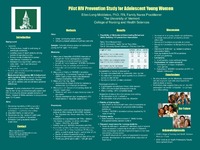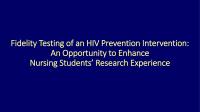Pilot HIV prevention study for adolescent young women
View File(s)
- Author(s)
- Details
-
Ellen R. Long-Middleton, RN, FNP-BC, FNAP
- Sigma Affiliation
- Kappa Tau
- Contributor Affiliation(s)
- University of Vermont, Burlington, Vermont, USA
Visitor Statistics
Visits vs Downloads
Visitors - World Map
Top Visiting Countries
| Country | Visits |
|---|
Top Visiting Cities
| City | Visits |
|---|
Visits (last 6 months)
Downloads (last 6 months)
Popular Works for Long-Middleton, Ellen R. by View
| Title | Page Views |
|---|
Popular Works for Long-Middleton, Ellen R. by Download
| Title | Downloads |
|---|
View Citations
Citations
Session presented on Thursday, July 21, 2016 and Friday, July 22, 2016:
Purpose: Human Immunodeficiency Virus (HIV)/Acquired Immunodeficiency Syndrome (AIDS) is a threat to the lives, health and well being of individuals worldwide. Among women of reproductive age, AIDS is the leading cause of death globally. Heterosexual transmission of HIV is the primary mode of infection in women, and adolescent young women are particularly vulnerable. As there is no cure currently for AIDS and no vaccine to protect against HIV, implementation of behavioral HIV prevention interventions that are culturally sensitive and inclusive is imperative. Motivational interviewing and behavioral skills building are modes of behavioral interventions that have proven to be efficacious and are dynamic and flexible enough to address cultural inclusiveness and sensitivity, as well as adolescent and adult developmental differences. Yet there is a need for further studies to establish proven HIV prevention interventions in general, and specifically studies that are geared toward reducing heterosexually mediated HIV infection in culturally diverse adolescent young women. Given that adolescents utilize primary health care services, an opportunity exists to reach adolescent young women and adapt proven HIV prevention interventions to their needs in primary care settings. The purpose of this study was to pilot a behavioral HIV prevention intervention to reduce heterosexually transmitted HIV in a culturally diverse sample inclusive of Black, Hispanic and White adolescent young women ages 15-19 years. The specific aims of the study were to: Determine the feasibility of an HIV prevention intervention involving motivational interviewing with behavioral skills building in a primary care setting. Establish fidelity of the intervention. Determine the training needs of health care providers who deliver the intervention. Enhance nursing students' research experience.
Methods: A brief primary care-based HIV prevention intervention, utilizing motivational interviewing and behavioral skills building techniques, has been implemented with a culturally diverse sample of Black, Hispanic and White adolescent women ages 15-19 years. There are two sites for the study: a federally funded community health center and a university-based adolescent clinic. Feasibility of the intervention has been assessed by: Length of time to collect the demographic and sexual practices data and implement the intervention Period of time for participant enrollment Integration of the intervention into a primary care setting. This study is in progress. Prior to implementing the pilot intervention in the clinical sites, fidelity of the intervention was established and the training needs of health care providers were determined with the assistance of three nursing students who served as research assistants (RAs). Education for the motivational interviewing/behavioral skills building HIV prevention intervention was provided to the RAs in multiple sessions. The sessions included didactic information, discussion, and clinical simulation. The Behaviour Change Counselling Index (BECCI) and the Motivational Interviewing Treatment Integrity Code (MITI) were used to establish fidelity for the HIV prevention intervention. Training needs were determined by length of time to achieve fidelity. Qualitative data has been collected pertaining to the nursing students' research experience.
Results: As the research is ongoing, the results are preliminary. Thus far, the time period for data collection and implementation of the HIV prevention intervention in a primary care practice is 15 to 20 minutes in length. Approximately two to three participants have been enrolled per three-hour clinic session. Clinic schedules were not disrupted during data collection or implementation of the intervention. Fidelity of the intervention was established after 12 hours of training. The nursing students reported a favorable and enriching experience as members of the research team.
Conclusion: Preliminary data suggest that a one-on-one HIV prevention intervention with established fidelity is feasible in an office-based setting.
Theme: Leading Global Research: Advancing Practice, Advocacy, and Policy
Items submitted to a conference/event were evaluated/peer-reviewed at the time of abstract submission to the event. No other peer-review was provided prior to submission to the Henderson Repository.
| Type | Poster |
| Acquisition | Proxy-submission |
| Review Type | Abstract Review Only: Reviewed by Event Host |
| Format | Text-based Document |
| Evidence Level | N/A |
| Research Approach | N/A |
| Keywords | HIV Prevention; Sexual Risk; Adolescent Young Women |
| Name | 27th international Nursing Research Congress |
| Host | Sigma Theta Tau International |
| Location | Cape Town, South Africa |
| Date | 2016 |
All rights reserved by the author(s) and/or publisher(s) listed in this item record unless relinquished in whole or part by a rights notation or a Creative Commons License present in this item record.
All permission requests should be directed accordingly and not to the Sigma Repository.
All submitting authors or publishers have affirmed that when using material in their work where they do not own copyright, they have obtained permission of the copyright holder prior to submission and the rights holder has been acknowledged as necessary.
Related items
Showing items related by title, author, creator and subjects.
-
HIV risk reduction behaviors in adolescent females: The influence of mastery and self-esteem
Long-Middleton, Ellen R. (2001-11-10)AIDS is a leading cause of death in adolescent and young adult populations. Heterosexual transmission of HIV is the fastest growing mode of infection among women, and minority populations are affected disproportionately. ... -
HIV risk reduction behaviors in adolescent females; The influence of mastery and self-esteem
Long-Middleton, Ellen R. (10/27/2011)Purpose. The purpose of the study was to test the moderator effect of mastery on the relationship between self-esteem and HIV risk reduction behaviors. Aims. The aims of this study were to: 1) examine the relationships ... -
Fidelity testing of an HIV prevention intervention: An opportunity to enhance nursing students’ research experience
Long-Middleton, Ellen R. (2018-04-03)The training needs of health care providers delivering an HIV prevention intervention were determined by incorporating graduate nursing students into fidelity testing of the behavioral intervention. Training needs were ... -
Perspectives of people living with HIV toward healthcare providers: Insights into multicultural health literacy
Long-Middleton, Ellen R.; Nicholas, Patrice Kenneally; Corless, Inge B.; Portillo, Carmen J.; Webel, Allison R.; Rivero-Mendez, Marta; Holzemer, William L.; Mogobe, Keitshokile Dintle; Kemppainen, Jeanne; Nokes, Kathleen M.; Cuca, Yvette; Reid, Paula; Eller, Lucille Sanzero; Wantland, Dean; Sabone, Motshedisi Boitumelo; Solis-Baez, Solymar; Gakumo, C. Ann; Fortinsky, Rachel; Dawson-Rose, Carol (2017-07-05)Purpose: To further our understanding about relationship influences that impact health literacy, the purpose of this study was to characterize the perspectives of a culturally diverse group of people living with HIV ... -
Differences in mastery and self-esteem in culturally diverse adolescent females
Long-Middleton, Ellen R. (2011-10-17)Purpose: Mastery, a global sense of control over one's life, and self-esteem, the value placed on oneself, are psychological characteristics associated with numerous health-enhancing behaviors. Developing interventions to ...





